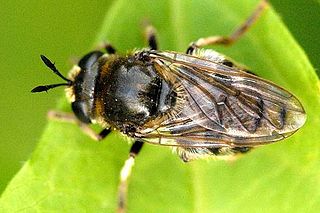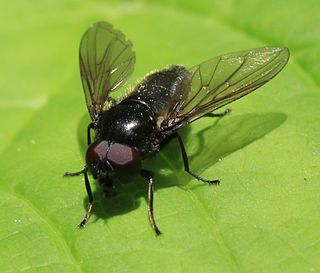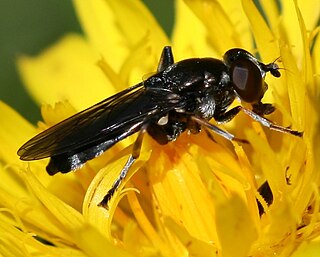
Hover flies, also called flower flies or syrphid flies, make up the insect family Syrphidae. As their common name suggests, they are often seen hovering or nectaring at flowers; the adults of many species feed mainly on nectar and pollen, while the larvae (maggots) eat a wide range of foods. In some species, the larvae are saprotrophs, eating decaying plant and animal matter in the soil or in ponds and streams. In other species, the larvae are insectivores and prey on aphids, thrips, and other plant-sucking insects.

Hover flies of the genus Microdon are unusual among the Diptera. Like other members of the subfamily, they are myrmecophiles, meaning they inhabit the nests of ants.

Platycheirus clypeatus is a species of hoverfly. It is found across the Palearctic and in the Nearctic. The larvae feed on aphids. Adults are usually found on the edges of woodland or scrub, heath or along hedgerows where they visit a wide range of flowers.

Eristalis intricaria is a European species of hoverfly. It is a furry bee mimic, superficially resembling Merodon, though Merodon have all black leg tibiae, as opposed to partly yellow. E. intricaria is somewhat variable in colour pattern, and some attempts at naming varieties have been tentatively made. Flight time of adults in the UK are from March to September. It is generally widespread, but is seldom seen in large numbers. Habitat is woodland or marshland.

Eupeodes corollae is a very common European species of hoverfly. Adults are 6–11 millimetres (0.24–0.43 in) in body length. Males and females have different marking on the abdomen; males have square commas on tergites 3 and 4, whereas females have narrow commas. Larvae feed on aphids. This species has been used experimentally in glasshouses as a method of aphid control, and to control scale insects and aphids in fruit plantations. They were found to be partial to the fruit, eating more fruit than aphids.

Eupeodes luniger is a common species of hoverfly.

Platycheirus peltatus is a Palearctic species of hoverfly.

Leucozona lucorum is a Palearctic and Nearctic species of hoverfly.

Platycheirus occultus is a Palearctic species of hoverfly.

Microdon mutabilis, is a species of hoverfly. It is found in many parts of Britain and Europe. The distinctive almost slug-like larvae live in ants' nests. They are hemispherical in shape, heavily armoured and believed to prey on the eggs and larvae of a number of ant species, including Formica lemani, Formica fusca, Lasius niger and Myrmica ruginodis. It was described by Carl Linnaeus in his landmark 1758 10th edition of Systema Naturae.

Microdon analis, is a species of hoverfly. It is found in the Palearctic. The distinctive almost slug-like larvae live in ants nests. The larvae are hemispherical in shape and heavily armoured. They are believed to prey on the eggs and larvae of a number of different ant species, notably Lasius niger and the Formica rufa group. These ants are usually found on heathland. However Schmid (2004) claims that Microdon analis and M. major which are cryptic species have been confused under the name analis. M.major is apparently associated with ants of the genus Formica, the other species, M.analis, with Lasius species.

Cheilosia vicina is a hoverfly species found in the Palearctic.

Platycheirus angustatus is a species of hoverfly. It is found in many parts of the Palearctic, and in the Nearctic.

Paragus haemorrhous, is a widespread species of hoverfly found in many parts of Europe, Africa and the Nearctic.

Melangyna umbellatarum is a Holarctic species of hoverfly.

Xylota jakutorum is a Palearctic species of hoverfly.

Eumerus funeralis or lesser bulb fly is a species of Hoverfly, from the family Syrphidae, in the order Diptera. E. funeralis appears in Peck (1988) as a synonym of E. strigatus (Fallen), but was reinstated as the correct name for tuberculatus Rondani, sensu auctorum by Speight et al. (1998).
Cheilosia ahenea is a Palearctic species of hoverfly.

Cheilosia vernalis is a Palearctic hoverfly.

Cheilosia praecox is a Palearctic hoverfly. Speight et al. (1998) indicate that the correct name for this species is C.urbana (Meigen)


















